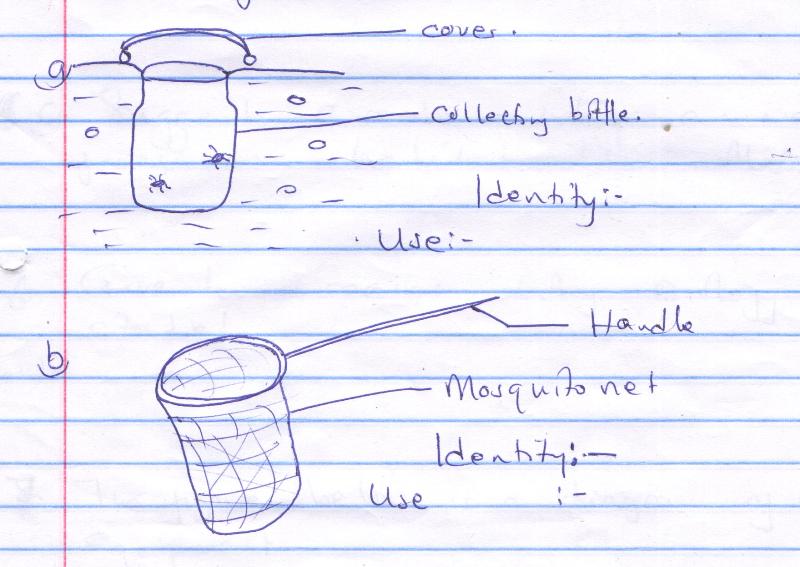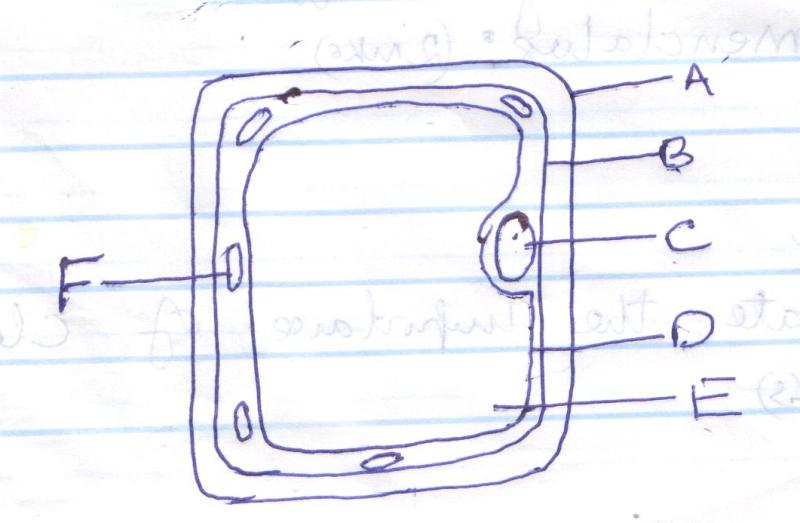- Name two major branches of Biology. (2 marks)
- Botany; Zoology.
- What is the name given to the following areas of study: (4 marks)
- Study of classification
- Taxonomy
- Study of Micro-organisms
- Microbiology
- Study of living things and their surroundings
- Ecology
- Study of the functioning of the body
- Physiology
- Study of classification
- Identify the following apparatus and state their functions.

- pit fall trap- used for catching crawling animals
- sweep net- used for catching flying insects
- List down two precautions that should be observed during collection and observation of specimens. (2 marks)
- Collect only the number of specimens you need
- Do not harm the specimens.
- Do not destroy the natural habitat.
- Handle the dangerous and inhumes specimens with care
-
- What do you understand with the following terms as used in characteristics of living things. (3 marks)
- Nutrition.
- Process by which organisms acquire and utilize food nutrients
- Respiration.
- Chemical break down of food to release energy.
- Growth.
- Increase in weight and size of an organism.
- Nutrition.
- Name three other characteristics of living things other than the one listed in 5(a) above. (3 marks)
- Movement/ locomotion
- Reproduction
- Gaseous exchange
- Excretion
- Suggest a reason why animals move from one habitat to another. (1 mark).
- Search for food
- Search for water.
- Escape from danger/ predators
- Seek new environment.
- What do you understand with the following terms as used in characteristics of living things. (3 marks)
- Give two reasons why Biology should be studied. (2 marks
- Understand the development stages of the human body.
- Pursue careers.
- Develop scientific skills e.g. observation.
- To solve environmental problem.
- The figure below is a diagram of biological equipment.

- Name the part labeled X. (1 mark)
- Frame.
- Give the use of the part X. (1 mark)
- to support the lens
- A student was provided with a specimen measuring 2 cm and drew an image measuring 5 cm. Give the formula used to calculate magnification and state the magnification of the image drawn. (2 marks)
- magnification= length of image/ length of specimen= 5/2= x2.5
- Name the part labeled X. (1 mark)
- Suggest a biological tool that is suitable for collecting each of the following organisms. (4 marks)
- Scorpion.
- a pair of forceps
- Rat.
- a bait trap
- Butterfly.
- sweep net
- Safari ants on a tree trunk.
- pooter
- Scorpion.
- Which characteristic of living organisms is shown by each of the following:- (2 marks)
- Cheetah chasing a gazelle.
- locomotion
- A germinating bean seed.
- growth and devlopment
- Cheetah chasing a gazelle.
- State the use of the following apparatus. (4 marks)
- A pit fall trap.
- Small craling organisms
- A pair of forceps.
- Hold specimen during observation
- A hand lens.
- to enlarge small specimen
- A sweep net.
- A pit fall trap.
- Draw a neat diagram showing a pooter. (4 marks)

- Name the first 5 TAXA into which living organisms are placed by biologists. (5 marks)
- Monera
- Protoctista.
- Fungi
- Plantae.
- Animalia.
- What do you understand by Binomial Nomenclature? (2 marks)
- Giving each organism two names; A genetic and a specific name;
- State the importance of classification in biology. (4 marks)
- To help in identifying living organisms into their correct groups for reference;
- Grouping bring together living organisms with similar characteristics but separate those with different features;
- To understand the evolutionary relationship between organisms
- To arrange information in an orderly manner;
- When classifying living organisms’ biologist use external features. List down the external features that can be used to classify the following plants and animals into their respective group.
- Seed producing plants. (2 marks)
- Leaf appearance.
- Types of flowers.
- Numbers of petals.
- Number of stamens
- Absence or presence of flowers
- Nature/ type of leaf apices
- Birds. (2 marks)
- Type of beaks.
- Type of claws/Talons/Shape of talons.
- Ability to fly/ size of wings.
- Length of beak/ size of beak.
- Colour of feathers/pluonage.
- Fish. (2 marks)
- Presence of scales
- Size of fins.
- Length of fish’s body.
- Colour of the body
- Shape of the mouth.
- Shape of head.
- Seed producing plants. (2 marks)
- Name the term used to describe the processes through which living organisms are classified. (1 mark)
- taxonomy
- Name the parts of the plant cell labeled A to F. (6 marks)

A- Cellulose cell wall
B- Cell membrane
C- Nucleus
D- Tonoplast
E- Cell vacuole
F- Chloroplast
- Name:-
- Two organisms in the kingdom Monera. (2 marks)
- Bacteria, Blue green algae.
- Three examples in the kingdom fungi. (3 marks)
- Mushroom, Yeast, Bread mould, toad stool.
- Three examples in the kingdom animalia. (3 marks)
- Any correctly spelt names of animals.
- Two organisms in the kingdom Monera. (2 marks)
- State the main characteristic of each of the following kingdoms. ( 5 marks)
- Monera.
- No nuclear membrane
- Protoctista.
- Single cell with nuclear membrane.
- Fungi.
- No chlorophyll, multicellular.
- Animalia.
- Not multicellular and do not make their own food.
- Plantae.
- Multicellular and make their own food through photosynthesis.
- Monera.
- What do you understand by the term species? (5 marks)
- A group of organisms that resembles one another; and can mate naturally; to produce a fertile offspring/young one.
Join our whatsapp group for latest updates
Tap Here to Download for 50/-
Get on WhatsApp for 50/-
Download BIOLOGY Marking Scheme - Form 1 End of Term 1 2019 Examinations.
Tap Here to Download for 50/-
Get on WhatsApp for 50/-
Why download?
- ✔ To read offline at any time.
- ✔ To Print at your convenience
- ✔ Share Easily with Friends / Students

